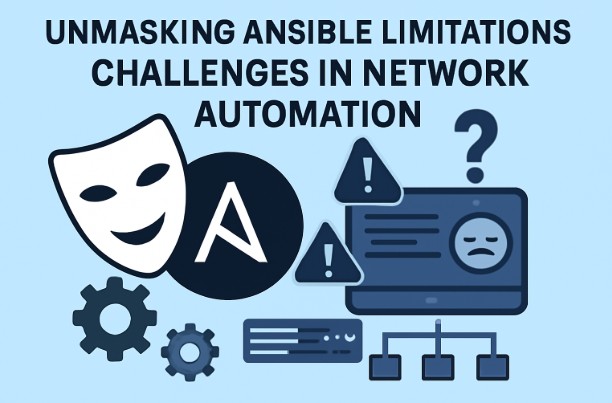Ansible, a powerful automation tool, has revolutionized IT operations, including network management. Its agentless architecture and simple YAML syntax make it appealing for automating various tasks. However, despite its popularity, Ansible possesses certain limitations, especially when tackling complex network automation scenarios. Understanding these Ansible limitations is crucial for network engineers to avoid potential pitfalls and choose the right tool for the job. This article delves into the key challenges and shortcomings associated with using Ansible for network automation, providing insights to help you make informed decisions for your infrastructure.
Table of Contents
Complexity and Scalability Challenges
While Ansible excels at automating simple tasks, handling complex, large-scale network deployments presents several challenges. Its reliance on SSH for communication can become a bottleneck when managing numerous devices simultaneously. The time required for task execution can significantly increase, leading to slower deployments and impacting overall efficiency. This limitation becomes more pronounced as the network grows in size and complexity.
Handling Multi-Vendor Environments
Network environments often consist of devices from various vendors, each with its own unique configuration language and CLI. Ansible’s ability to handle this heterogeneity depends on the availability and quality of network modules. While Ansible boasts a vast collection of modules, gaps in support for specific vendor devices or features can limit automation capabilities. You may need to resort to custom scripting or workarounds, adding complexity and maintenance overhead.
State Management and Idempotency Issues
Maintaining a consistent and desired state across a large network is paramount. Ansible’s idempotency feature ensures tasks are executed only once, preventing unintended configuration changes. However, in complex scenarios involving dependencies or race conditions, ensuring idempotency across all tasks can be difficult. Carefully planned task sequences and thorough testing are crucial to mitigate this risk.
Ansible Limitations in Real-Time Network Operations
Ansible’s asynchronous nature can be a drawback when dealing with real-time network events. The reliance on polling and indirect communication methods makes it less suitable for situations requiring immediate responses, such as handling network outages or dynamically adjusting routing protocols. Tools specifically designed for real-time network monitoring and control may be necessary to complement Ansible’s capabilities.
Lack of Native Support for Real-time Protocols
Ansible doesn’t have built-in support for real-time network protocols like NetFlow or sFlow. This lack of native integration limits its ability to collect real-time network performance data and react to network changes dynamically. Integrating other monitoring tools and customizing Ansible playbooks to process their output is often required, adding complexity to the automation process.
Security Concerns
Security is a primary concern in network automation. Ansible’s reliance on SSH for communication means that the security of SSH keys and access control mechanisms directly affect the security of your network automation tasks. A compromised SSH key could give unauthorized access to your entire network. Robust key management practices and appropriate access controls are therefore essential when using Ansible for network automation.
Managing SSH Keys and Access Control
Ansible uses SSH keys to securely connect to network devices. Improper management of SSH keys can lead to security vulnerabilities. Best practices include utilizing separate keys for different environments, rotating keys regularly, and employing strong passwords or passphrase protection.
Debugging and Troubleshooting
Debugging Ansible playbooks in network automation can be challenging. Error messages may not always be clear, and identifying the root cause of failures can require in-depth knowledge of Ansible, network protocols, and the specific vendor devices involved. Effective logging practices and the use of debugging tools are essential to streamline troubleshooting.
Limited Network Device Visibility
Ansible primarily interacts with network devices through their CLI. This can limit visibility into the internal state of the devices, making debugging more difficult. Using network monitoring tools in conjunction with Ansible can enhance visibility and simplify troubleshooting.
Ansible Limitations: Addressing the Gaps
While Ansible presents several advantages for network automation, its limitations necessitate a strategic approach. Recognizing these shortcomings enables you to plan effectively and mitigate potential issues. Understanding the complexities of multi-vendor environments and the need for robust error handling and logging is critical for successful Ansible deployment in network automation.
- Consider alternative solutions: For tasks requiring real-time interaction or deep integration with specific network protocols, explore other tools alongside Ansible, leveraging each tool’s strengths.
- Invest in proper training and expertise: Proficient Ansible skills, coupled with deep network expertise, are essential for navigating the challenges inherent in network automation.
- Employ robust error handling and logging: Comprehensive logging and well-designed error handling mechanisms facilitate faster debugging and troubleshooting.
Frequently Asked Questions
Q1: Is Ansible suitable for all network automation tasks?
A1: Ansible is a powerful tool, but not a one-size-fits-all solution. Its strengths lie in automating configuration changes and tasks that don’t require real-time interactions. For real-time monitoring and control, other tools are typically more appropriate.
Q2: How can I overcome Ansible’s limitations in complex network environments?
A2: Employing modular design principles, using role-based access control, and leveraging advanced Ansible features like dynamic inventories and connection plugins are helpful strategies. Careful planning and extensive testing are also crucial.
Q3: What are the best practices for secure Ansible deployments in network automation?
A3: Employ strong SSH key management practices, restrict access using appropriate roles and permissions, and regularly audit your Ansible configuration and execution logs to detect and address potential security vulnerabilities.
Q4: How can I improve debugging and troubleshooting when using Ansible for network automation?
A4: Implement comprehensive logging, use Ansible’s debugging features, and leverage network monitoring tools to gain visibility into the network’s state. Start with simple playbooks and gradually increase complexity to facilitate easier debugging.

Conclusion
Ansible’s versatility makes it a valuable tool for network automation; however, its limitations, particularly regarding scalability, real-time operations, and debugging, should be carefully considered. Understanding these Ansible limitations allows you to develop more effective strategies, utilize complementary tools, and build robust and secure network automation solutions. By proactively addressing potential challenges, you can maximize Ansible’s benefits and minimize its drawbacks, ultimately leading to more efficient and reliable network operations. Remember that choosing the right tool for the specific task is key to successful network automation. Thank you for reading the DevopsRoles page!
For further information, refer to the official Ansible documentation: https://docs.ansible.com/ and explore network automation best practices on sites like Network Automation: https://www.networkautomation.io/

